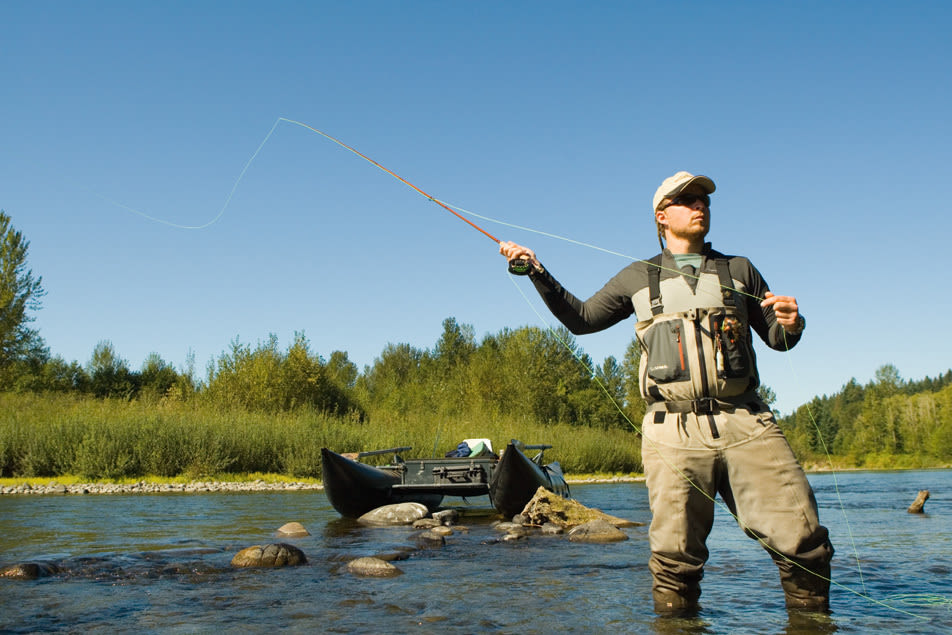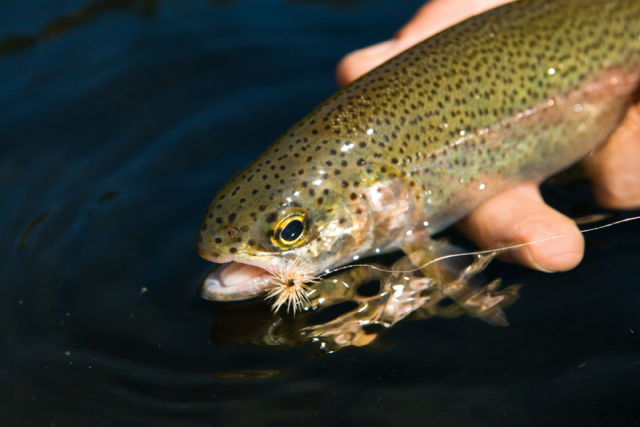Casting Call

Image: Daniel Root
When you take hold of a hand-tied fly, be it a Quigley’s Hackle Stacker, a Poly Wing Trico Spinner or maybe even a Gulper Special, the first thing you’ll notice is what’s missing—heft. Designed to imitate the fuzzy little critters on which river denizens feed, fishing flies, made of silky fibers that range from rayon chenille to caribou hair, are as light as a dandelion puff. But to catch a trout with one, you’ll need enough force and skill to land that little Gulper Special, along with its miniature hook, at a precise spot on the water’s surface some 60 feet away; fix your gaze upon it; and at the exact moment when that rainbow trout rises to bite, strike your rod to implant the hook squarely in the hungry fish’s mouth.
At least that’s what’s supposed to happen, according to Jad Donaldson, a 32-year-old bearded guide with Kaufmann Streamborn, a Tigard fly-fishing outfitter founded in 1970. With Gore-Tex waders pulled up to our chests, we’re standing waist-deep in the cool green current of the Clackamas River, a rainwater- and meltwater-fed gem that meanders for 83 miles from the Olallie Lake Basin high in the Cascade Range all the way down to the Willamette River. It’s an idyllic setting for someone attempting to learn fly fishing’s most celebrated feat: the overhead cast. Composed of graceful, arcing twirls and humming whirls, a fly cast, when executed by a master, dances in the air like a ribbon unfurling on a soft afternoon breeze.
But as I watch a tangled mass of line—mine—come hurtling toward my head, hook and all, I realize that becoming a master doesn’t come without patience, practice and most of all, a solid back cast. “Easy, easy! There’s a hook in there!” Donaldson admonishes before ducking his face behind the sun-baked brim of his fly-studded baseball cap. Luckily, nearly 25 years of fly fishing on waters everywhere from Alaska to the South Pacific’s Christmas Island has imbued him with the patience of a saint. Still chuckling, he offers to help me unravel the web of neon green line entangled around the end of my rod so we can begin again.
When I arranged my excursion inside Kaufmann Streamborn’s hickory-floored shop earlier in the week, I explained that I had tried fly fishing a time or two before, mainly courtesy of a friend who tied flies and sold rods for an outfitter in Jackson, Wyo. On his trips down the Snake River, I’d tag along, standing at the bow of a two-seat drift boat, trying to catch on. Inevitably, I found the long spools of fly line difficult to manage, the cutthroat trout hard to spot. And the casting? Forget it. As a result, I hadn’t touched a rod in years, yet Donaldson assured me we’d definitely land some fish today. An eager acolyte, I chose to believe.
My faith was buoyed by the reputation of our destination, a roughly five-mile stretch of the Clackamas River that flows through Milo McIver State Park, located just 35 driving miles from Portland. While anglers from the world over make pilgrimages to central Oregon’s rivers like the McKenzie and the Deschutes to catch blue-ribbon trout during the renowned salmon-fly hatch in late spring, the Clackamas is one of the state’s best year-round steelhead rivers. It also happens to be home to rainbow trout and one of Oregon’s last viable native coho salmon runs. To top it off, just upstream from the southeastern end of McIver Park, where we launched Donaldson’s custom-made 16-foot Cataraft into the Clackamas, the Eagle Creek Hatchery releases as many as 500,000 hungry catch-and-keep coho salmon smolts annually.

Image: Daniel Root
All of which explains why Kaufmann’s guides choose to lead their two-day fly-fishing crash courses here several times a month. After all, lots of biting fish make it easier for novices like me to gain more self-confidence. Three hours later, however, and despite the fact that I had begun to nail the basic casting technique—lock the wrist; power the rod from the elbow; halt the arm at 1 o’clock on the back cast; pause; let the line straighten; and then swing the rod forward, halting at 10 o’clock—I still hadn’t landed our intended quarry.
I’d fished a pool where we had spied some generously sized fish taking shelter from the current. No trout. I’d worked a nice “foam line,” a rollicking seam of river schmutz that traps fledgling bugs in its froth (and which Donaldson likened to a conveyor belt of fish food). Skunked again. As we bobbed along toward the park’s northwest border and its last boat ramp, where we intended to exit, I feared the worst—a troutless day.
But then Donaldson eyed one last chance for redemption—a spot near the river’s northern embankment where a tangle of alder and maple branches lurched over the slow-moving water, turning it black with shadows. This place, he explained, would be a good spot to find fish avoiding the late afternoon sun, so he moored our craft on a sandy bar, where I clipped into my waders and followed him into the murky water. Some 60 feet away, we could see trout breaking the surface with hair-raising kerplunks. “Those are big ones,” Donaldson said, followed by: “All right, this is your final exam.”
At the moment, as I watch him untangle my foozled cast that nearly hooked us, it’s apparently a test I am flunking. I cast again, but it falls short. I strip out more line, tighten my fingers around the rod’s cork handle and whip it behind my head. The line springs to life and unravels some 40 feet behind me. When it finally straightens, I snap the rod forward and send the tiny caddis fly tied to the end of my line hurtling toward my prey.
“That’s a good cast. Now keep your eyes on it,” Donaldson says, referring to my fly perched daintily on the water. And even though my miniature piece of jetsam is merely a speck on a vast moving wall of water, there’s no mistaking the feeling when a fish rises and strikes. Beaming, I lift the rod skyward to pull in a young, 10-inch steelhead trout.
Eager to repeat the moment, I let my line straighten in the current and cast again. Within minutes, I snag a slightly larger trout. “Now you’re catching trout!” Donaldson yells proudly as I reel it in. Just before setting the fish free, I imagine the day it will return to its home waters as a mighty 12-lb fighter.
And later, over a few celebratory Twilight Ales, if anyone happens to ask, I imagine I’ll tell them the fish were all enormous and all my casts unfurled like ribbons dancing over the river—and that I’ll definitely be back again.




